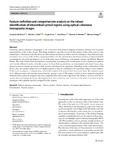Mostrar o rexistro simple do ítem
Feature Definition and Comprehensive Analysis on the Robust Identification of Intraretinal Cystoid Regions Using Optical Coherence Tomography Images
| dc.contributor.author | Moura, Joaquim de | |
| dc.contributor.author | Vidal, Plácido | |
| dc.contributor.author | Novo Buján, Jorge | |
| dc.contributor.author | Rouco, J. | |
| dc.contributor.author | Penedo, Manuel | |
| dc.contributor.author | Ortega Hortas, Marcos | |
| dc.date.accessioned | 2022-03-23T18:42:30Z | |
| dc.date.available | 2022-03-23T18:42:30Z | |
| dc.date.issued | 2022 | |
| dc.identifier.citation | de Moura, J., Vidal, P.L., Novo, J. et al. Feature definition and comprehensive analysis on the robust identification of intraretinal cystoid regions using optical coherence tomography images. Pattern Anal Applic 25, 1–15 (2022). https://doi.org/10.1007/s10044-021-01028-1 | es_ES |
| dc.identifier.issn | 1433-755X | |
| dc.identifier.uri | http://hdl.handle.net/2183/30196 | |
| dc.description | Financiado para publicación en acceso aberto: Universidade da Coruña/CISUG | es_ES |
| dc.description.abstract | [Abstract] Currently, optical coherence tomography is one of the most used medical imaging modalities, offering cross-sectional representations of the studied tissues. This image modality is specially relevant for the analysis of the retina, since it is the internal part of the human body that allows an almost direct examination without invasive techniques. One of the most representative cases of use of this medical imaging modality is for the identification and characterization of intraretinal fluid accumulations, critical for the diagnosis of one of the main causes of blindness in developed countries: the Diabetic Macular Edema. The study of these fluid accumulations is particularly interesting, both from the point of view of pattern recognition and from the different branches of health sciences. As these fluid accumulations are intermingled with retinal tissues, they present numerous variants according to their severity, and change their appearance depending on the configuration of the device; they are a perfect subject for an in-depth research, as they are considered to be a problem without a strict solution. In this work, we propose a comprehensive and detailed analysis of the patterns that characterize them. We employed a pool of 11 different texture and intensity feature families (giving a total of 510 markers) which we have analyzed using three different feature selection strategies and seven complementary classification algorithms. By doing so, we have been able to narrow down and explain the factors affecting this kind of accumulations and tissue lesions by means of machine learning techniques with a pipeline specially designed for this purpose. | es_ES |
| dc.description.sponsorship | Instituto de Salud Carlos III, Government of Spain, DTS18/00136 research project; Ministerio de Ciencia e Innovación y Universidades, Government of Spain, RTI2018-095894-B-I00 research project, Ayudas para la formación de profesorado universitario (FPU), grant ref. FPU18/02271; Ministerio de Ciencia e Innovación, Government of Spain through the research project with reference PID2019-108435RB-I00; Consellería de Cultura, Educación e Universidade, Xunta de Galicia, Grupos de Referencia Competitiva, grant ref. ED431C 2020/24 and through the postdoctoral grant contract ref. ED481B 2021/059; Axencia Galega de Innovación (GAIN), Xunta de Galicia, grant ref. IN845D 2020/38; CITIC, Centro de Investigación de Galicia ref. ED431G 2019/01, receives financial support from Consellería de Educación, Universidade e Formación Profesional, Xunta de Galicia, through the ERDF (80%) and Secretaría Xeral de Universidades (20%). Open Access funding provided thanks to the CRUE-CSIC agreement with Springer Nature. Funding for open access charge: Universidade da Coruña/CISUG | es_ES |
| dc.description.sponsorship | Xunta de Galicia; ED431C 2020/24 | es_ES |
| dc.description.sponsorship | Xunta de Galicia; ED481B 2021/059 | es_ES |
| dc.description.sponsorship | Xunta de Galicia; IN845D 2020/38 | es_ES |
| dc.description.sponsorship | Xunta de Galicia; ED431G 2019/01 | es_ES |
| dc.language.iso | eng | es_ES |
| dc.publisher | Springer | es_ES |
| dc.relation | info:eu-repo/grantAgreement/MICINN/Plan Estatal de Investigación Científica y Técnica y de Innovación 2017-2020/DTS18%2F00136/ES/Plataforma online para prevención y detección precoz de enfermedad vascular mediante análisis automatizado de información e imagen clínica/ | |
| dc.relation | info:eu-repo/grantAgreement/AEI/Plan Estatal de Investigación Científica y Técnica y de Innovación 2017-2020/RTI2018-095894-B-I00/ES/DESARROLLO DE TECNOLOGIAS INTELIGENTES PARA DIAGNOSTICO DE LA DMAE BASADAS EN EL ANALISIS AUTOMATICO DE NUEVAS MODALIDADES HETEROGENEAS DE ADQUISICION DE IMAGEN OFTALMOLOGICA/ | |
| dc.relation | info:eu-repo/grantAgreement/MICINN/Plan Estatal de Investigación Científica y Técnica y de Innovación 2017-2020/FPU18%2F02271/ES/ | |
| dc.relation | info:eu-repo/grantAgreement/AEI/Plan Estatal de Investigación Científica y Técnica y de Innovación 2017-2020/PID2019-108435RB-I00/ES/CUANTIFICACION Y CARACTERIZACION COMPUTACIONAL DE IMAGEN MULTIMODAL OFTALMOLOGICA: ESTUDIOS EN ESCLEROSIS MULTIPLE/ | |
| dc.relation.uri | https://doi.org/10.1007/s10044-021-01028-1 | es_ES |
| dc.rights | Atribución 4.0 Internacional | es_ES |
| dc.rights.uri | http://creativecommons.org/licenses/by/4.0/ | * |
| dc.subject | Optical coherence tomography | es_ES |
| dc.subject | Texture analysis | es_ES |
| dc.subject | Feature selection | es_ES |
| dc.subject | Computer-aided diagnosis | es_ES |
| dc.subject | Classification | es_ES |
| dc.subject | Feature analysis | es_ES |
| dc.title | Feature Definition and Comprehensive Analysis on the Robust Identification of Intraretinal Cystoid Regions Using Optical Coherence Tomography Images | es_ES |
| dc.type | info:eu-repo/semantics/article | es_ES |
| dc.rights.access | info:eu-repo/semantics/openAccess | es_ES |
| UDC.journalTitle | Pattern Analysis and Applications | es_ES |
| UDC.volume | 25 | es_ES |
| UDC.startPage | 1 | es_ES |
| UDC.endPage | 15 | es_ES |
| dc.identifier.doi | 10.1007/s10044-021-01028-1 |
Ficheiros no ítem
Este ítem aparece na(s) seguinte(s) colección(s)
-
GI-VARPA - Artigos [79]






